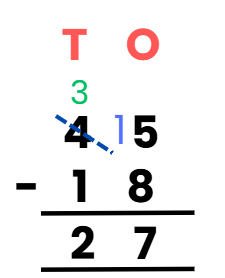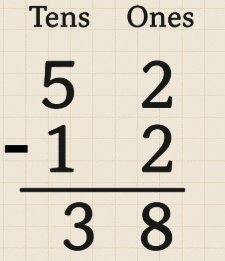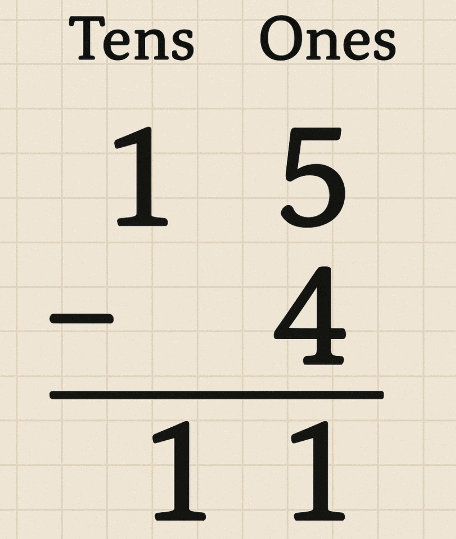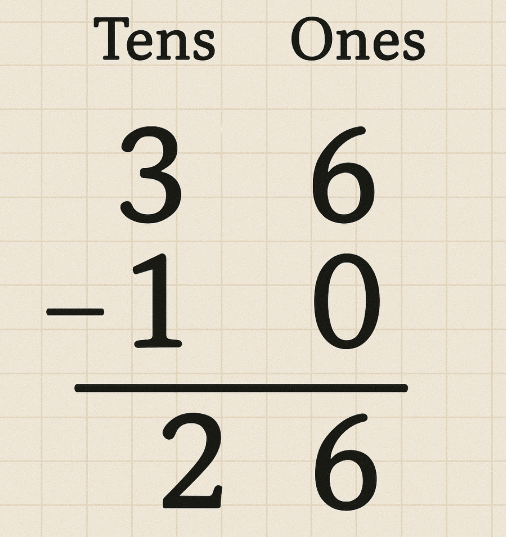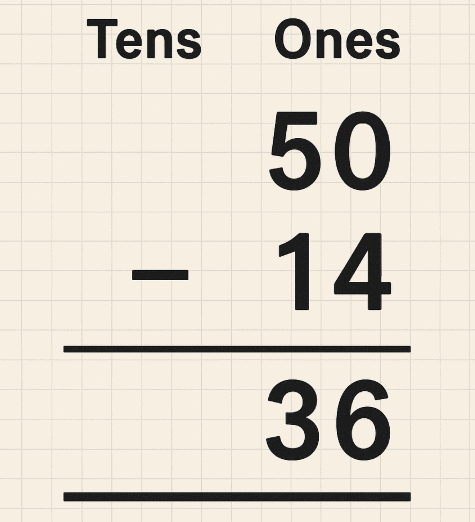Everyday Mathematics: Subtraction | Mathematics Olympiad for Class 1 PDF Download
Q1. A shopkeeper has 45 pens on display. He sells 18 pens during the day. How many pens are left?
(a) 25
(b) 27
(c) 23
(d) 30
Ans: (b) 27
To find the number of pens left, subtract the number sold from the total:
45 - 18 = 27.
Q2. Riya has 10 marbles in her collection. She gives 3 marbles to her friend. How many marbles does she have now?
(a) 13
(b) 7
(c) -13
(d) -7
Ans: (b) 7
Subtract the marbles given away from the total:
10 - 3 = 7.
Riya has 7 marbles left.
Q3. A fruit seller had 50 oranges. If 12 oranges are not sold by the end of the day, how many oranges were sold?
(a) 38
(b) 40
(c) 36
(d) 42
Ans: (a) 38
To find the number sold, subtract the number not sold from the total: 50 - 12 = 38.
Q4. A teacher marks a test out of 20. A student loses 6 marks for wrong answers. How many marks does the student get?
(a) 16
(b) 14
(c) 13
(d) 15
Ans: (b) 14
Subtract the marks lost from the maximum marks: 20 - 6 = 14.
Using backward counting: Start at 20 and count back 6 steps (20 → 19 → 18 → 17 → 16 → 15 → 14).
The student gets 14 marks.
Q5. A box contains 13 chocolates. If 9 chocolates are eaten, how many are left?
(a) 4
(b) 5
(c) 22
(d) 19
Ans: (a) 4
Using the striking-out method: Imagine 13 chocolates:
Strike out 9:
Count the remaining:
4 are left. So, 13 - 9 = 4.
Q6. A boy has 15 balloons, and 4 burst during a party. How many balloons are still there?
(a) 10
(b) 11
(c) 12
(d) 9
Ans: (b) 11
Subtract the number of balloons that burst from the total: 15 - 4 = 11.
Q7. A gardener plants 40 flowers in a park. If 13 flowers do not grow, how many flowers are growing?
(a) 27
(b) 28
(c) 26
(d) 29
Ans: (a) 27
Subtract the flowers that do not grow from the total: 40 - 13 = 27.
Using a number line: Start from 40 and jump 13 units left
(40 → 39 → 38 → ... → 27).
So, 27 flowers are growing.
Q8. A store has 36 toys. If 10 toys are given away as gifts, how many toys remain?
(a) 25
(b) 26
(c) 27
(d) 24
Ans: (b) 26
Q9. A girl saves 25 rupees. She spends 8 rupees on a snack. How much money does she have left?
(a) 16
(b) 17
(c) 18
(d) 15
Ans: (b) 17
Subtract the amount spent from the total savings: 25 - 8 = 17.
Using backward counting: Start at 25 and count back 8 steps.
(25 → 24 → 23 → 22 → 21 → 20 → 19 → 18 → 17).
She has 17 rupees left.
Q10. A library has 50 books on a shelf. If 14 books are borrowed, how many books are left on the shelf?
(a) 34
(b) 36
(c) 35
(d) 38
Ans: (b) 36
|
29 videos|114 docs|69 tests
|
FAQs on Everyday Mathematics: Subtraction - Mathematics Olympiad for Class 1
| 1. What is subtraction and why is it important for Class 1 students? |  |
| 2. How can parents help their children practice subtraction at home? |  |
| 3. What are some fun activities to teach subtraction to Class 1 students? |  |
| 4. What are some common mistakes Class 1 students make when learning subtraction? |  |
| 5. How do teachers assess subtraction skills in Class 1 students? |  |

